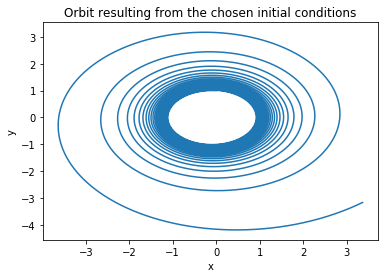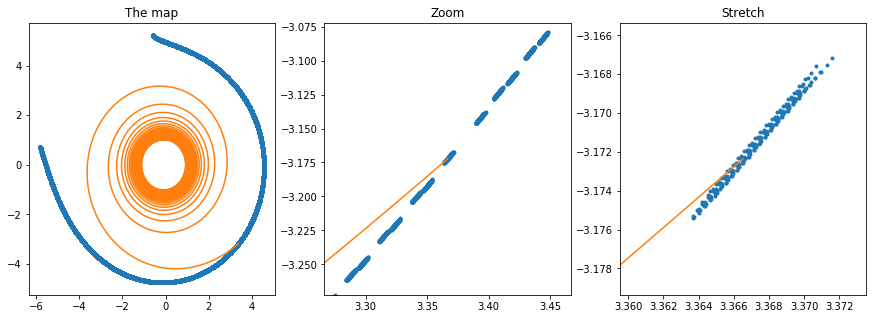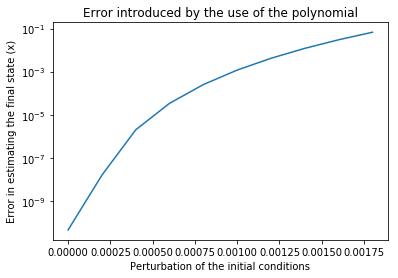High Order Taylor Maps II
(by Dario Izzo)
In this notebook we consider the system of differential equations \(\dot{\mathbf y} = \mathbf f(\mathbf y)\):
which describe, in non dimensional units, the motion of a mass point object around some primary body perturbed by a fixed thrust \(T\) acting in the direction perpendicular to the radius vector. We show how we can build a high order Taylor map (HOTM, indicated with \(\mathcal M\)) representing the final state of the system at the time \(T\) as a function of the initial conditions.
In other words, we build a polinomial representation of the relation \(\mathbf y(T) = \mathbf f(\mathbf y(0), T)\). Writing the initial conditions as \(\mathbf y(0) = \overline {\mathbf y}(0) + \mathbf {dy}\), our HOTM will be written as:
and will be valid in a neighbourhood of \(\overline {\mathbf y}(0)\).
[1]:
# We use numpy for arrays and pyaudi for the differential algebra machinery
import numpy as np
import matplotlib.pyplot as plt
%matplotlib inline
from pyaudi import gdual_double as gdual
from pyaudi import sin, cos
[2]:
# This is a simple Runga Kutta fourth order numerical integrator with fixed step.
# It is programmed to work both with floats and gduals. It infers the type from the initial conditions
def rk4(f, t0, y0, h, N):
t = t0 + np.arange(N+1)*h
y = np.array([[type(y0[0])] * np.size(y0)] * (N+1))
y[0] = y0
for n in range(N):
xi1 = y[n]
f1 = f(t[n], xi1)
xi2 = y[n] + (h/2.)*f1
f2 = f(t[n+1], xi2)
xi3 = y[n] + (h/2.)*f2
f3 = f(t[n+1], xi3)
xi4 = y[n] + h*f3
f4 = f(t[n+1], xi4)
y[n+1] = y[n] + (h/6.)*(f1 + 2*f2 + 2*f3 + f4)
return y
[3]:
# The Equations of Motion of Keplerian motion in non dimensional spherical coordinates.
T = 1e-3
def eom_kep_polar(t,y):
return np.array([y[1], - 1 / y[0] / y[0] + y[0] * y[3]*y[3], y[3], -2*y[3]*y[1]/y[0] - T])
We perform the numerical integration using floats (the standard way)
[4]:
# Fixed step size
step = 0.01
# Number of steps
n_steps = 30000
# The initial conditions
ic = [1.,0.1,0.,-1.]
# The intitial time (irrelevant as the system is autonomous)
it = 0.
y = rk4(eom_kep_polar, it, ic, step, n_steps)
[5]:
# Here we transform from polar to cartesian coordinates
# to then plot
cx = [it[0]*np.sin(it[2]) for it in y]
cy = [it[0]*np.cos(it[2]) for it in y]
plt.plot(cx,cy)
plt.title("Orbit resulting from the chosen initial conditions")
plt.xlabel("x")
plt.ylabel("y")
[5]:
Text(0,0.5,'y')

We perform the numerical integration using gduals (to get a HOTM)
[6]:
# Order of the Taylor Map. If we have 4 variables the number of terms in the Taylor expansion in 329 at order 7
order = 6
# We now define the initial conditions as gdual (not float)
ic_g = [gdual(ic[0], "r", order), gdual(ic[1], "vr", order), gdual(ic[2], "t", order), gdual(ic[3], "vt", order)]
[7]:
import time
start_time = time.time()
# We call the numerical integrator, this time it will compute on gduals
y = rk4(eom_kep_polar, it, ic_g, step, n_steps)
print("--- %s seconds ---" % (time.time() - start_time))
--- 183.67201781272888 seconds ---
[8]:
# We extract the last point
yf = y[-1]
# And unpack it into some convinient names
rf,vrf,tf,vtf = yf
# We compute the final cartesian components
xf = rf * sin(tf)
yf = rf * cos(tf)
# Note that you can get the latex representation of the gdual
print(xf._repr_latex_())
print("xf (latex):")
xf
\[ 0.528727{dt}^{3}+812961{dr}{dt}^{3}{dvt}-76468.3{dr}{dt}^{3}{dvr}-4.15449e+11{dr}^{2}{dvr}^{3}+2.8007e+12{dr}^{3}{dt}{dvt}-516.738{dt}^{3}{dvt}-7.651e+07{dr}^{2}{dt}^{3}{dvr}-5.40986e+08{dr}^{3}{dt}^{3}+1.54096e+12{dt}{dvr}^{2}{dvt}^{3}+6.053e+14{dr}^{2}{dt}{dvt}^{3}-1380.12{dt}^{2}{dvt}+4.15004e+11{dr}{dvr}^{3}{dvt}-3.72337e+08{dr}{dt}{dvr}^{3}-1.68326{dt}^{2}-3.17062e+14{dr}{dvr}^{3}{dvt}^{2}+2.6941e+07{dvr}^{5}-1.63654e+10{dr}^{2}{dt}{dvr}^{2}-1.47832e+09{dr}^{3}{dt}^{2}+48.4846{dt}^{3}{dvr}+1.98873e+06{dt}^{3}{dvr}^{2}{dvt}+\ldots+\mathcal{O}\left(7\right) \]
xf (latex):
[8]:
[9]:
# We can extract the value of the polinomial when $\mathbf {dy} = 0$
print("Final x from the gdual integration", xf.constant_cf)
print("Final y from the gdual integration", yf.constant_cf)
# And check its indeed the result of the 'reference' trajectory (the lineariation point)
print("\nFinal x from the float integration", cx[-1])
print("Final y from the float integration", cy[-1])
Final x from the gdual integration 3.3665168110417256
Final y from the gdual integration -3.1723626941974543
Final x from the float integration 3.3665168110875494
Final y from the float integration -3.172362694145616
We visualize the HOTM
[10]:
# Let us now visualize the Taylor map by creating a grid of perturbations on the initial conditions and
# evaluating the map for those values
Npoints = 20 # 10000 points
epsilon = 1e-3
grid = np.arange(-epsilon,epsilon,2*epsilon/Npoints)
nxf = [0] * len(grid)**4
nyf = [0] * len(grid)**4
i=0
import time
start_time = time.time()
for dr in grid:
for dt in grid:
for dvr in grid:
for dvt in grid:
nxf[i] = xf.evaluate({"dr":dr, "dt":dt, "dvr":dvr,"dvt":dvt})
nyf[i] = yf.evaluate({"dr":dr, "dt":dt, "dvr":dvr,"dvt":dvt})
i = i+1
print("--- %s seconds ---" % (time.time() - start_time))
--- 7.01151704788208 seconds ---
[11]:
f, axarr = plt.subplots(1,3,figsize=(15,5))
# Normal plot of the final map
axarr[0].plot(nxf,nyf,'.')
axarr[0].plot(cx,cy)
axarr[0].set_title("The map")
# Zoomed plot of the final map (equal axis)
axarr[1].plot(nxf,nyf,'.')
axarr[1].plot(cx,cy)
axarr[1].set_xlim([cx[-1] - 0.1, cx[-1] +0.1])
axarr[1].set_ylim([cy[-1] - 0.1, cy[-1] +0.1])
axarr[1].set_title("Zoom")
# Zoomed plot of the final map (unequal axis)
axarr[2].plot(nxf,nyf,'.')
axarr[2].plot(cx,cy)
axarr[2].set_xlim([cx[-1] - 0.007, cx[-1] + 0.007])
axarr[2].set_ylim([cy[-1] - 0.007, cy[-1] + 0.007])
axarr[2].set_title("Stretch")
#axarr[1].set_xlim([cx[-1] - 0.1, cx[-1] + 0.1])
#axarr[1].set_ylim([cy[-1] - 0.1, cy[-1] + 0.1])
[11]:
Text(0.5,1,'Stretch')

How much faster is now to evaluate the Map rather than perform a new numerical integration?
[12]:
# First we profile the method evaluate (note that you need to call the method 4 times to get the full state)
[13]:
timeit xf.evaluate({"dr":epsilon, "dt":epsilon, "dvr":epsilon,"dvt":epsilon})
20 µs ± 966 ns per loop (mean ± std. dev. of 7 runs, 10000 loops each)
[14]:
# Then we profile the Runge-Kutta 4 integrator
[15]:
timeit rk4(eom_kep_polar, 0, [it + epsilon for it in ic], step, n_steps)
774 ms ± 16.7 ms per loop (mean ± std. dev. of 7 runs, 1 loop each)
[16]:
# It seems the speedup is 2-3 orders of magnitude, but did we loose precision?
# We plot the error in the final result as computed by the HOTM and by the Runge-Kutta
# as a function of the distance from the original initial conditions
out = []
pert = np.arange(0,2e-3,2*1e-4)
for epsilon in pert:
res_map_xf = xf.evaluate({"dr":epsilon, "dt":epsilon, "dvr":epsilon,"dvt":epsilon})
res_int = rk4(eom_kep_polar, 0, [it + epsilon for it in ic], step, n_steps)
res_int_x = [it[0]*np.sin(it[2]) for it in res_int]
res_int_xf = res_int_x[-1]
out.append(np.abs(res_map_xf - res_int_xf))
plt.semilogy(pert,out)
plt.title("Error introduced by the use of the polynomial")
plt.xlabel("Perturbation of the initial conditions")
plt.ylabel("Error in estimating the final state (x)")
[16]:
Text(0,0.5,'Error in estimating the final state (x)')
